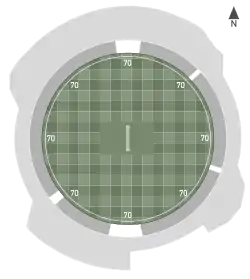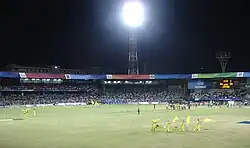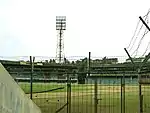Wankhede Stadium
Wankhede Stadium (pronounced [ʋaːnkʰeɖe]) is an international cricket stadium in Mumbai, India.[2] It is owned and operated by Mumbai Cricket Association (MCA) and is the home ground of the Mumbai Indians. It houses the headquarters of MCA, the Board of Control for Cricket in India (BCCI), and the Indian Premier League (IPL).
 Wankhede Stadium during the 2011 Cricket World Cup Final | |
| Address | Netaji Subhash Chandra Bose Rd, Churchgate, Mumbai (South), Maharashtra, India |
|---|---|
| Location | Churchgate, Mumbai, Maharashtra, India |
| Public transit | |
| Owner | Mumbai Cricket Association |
| Operator | Mumbai Cricket Association |
| Seating type | Stadium seating |
| Capacity | 32,000 (2011–present)[1] 39,000 (1974–2010)[1] |
| Surface | Grass |
| Construction | |
| Architect | Shashi Prabhu and Associates (1974) Shashi Prabhu and Associates and P.K. Das and associates (2017) |
| Ground information | |
| Tenants | Mumbai cricket team Mumbai Indians India national cricket team |
| End names | |
Tata End  Garware Pavilion End | |
| International information | |
| First Test | 23–29 January 1975: |
| Last Test | 3–7 December 2021: |
| First ODI | 17 January 1987: |
| Last ODI | 24 October 2023: |
| First T20I | 22 December 2012: |
| Last T20I | 3 January 2023: |
| Only women's Test | 10–13 February 1984: |
| First WODI | 23 December 1997: |
| Last WODI | 28 February 2019: |
| Only WT20I | 31 March 2016: |
| As of 17 March 2023 Source: Cricinfo | |
The stadium is situated near Marine Drive in the Churchgate neighbourhood. Several old cricket clubs are near the stadium, including Hindu Gymkhana, Parsi Gymkhana and Cricket Club of India (CCI).
The stadium has been host to numerous high-profile cricket matches in the past, most notably the 2011 Cricket World Cup Final, in which India defeated Sri Lanka and became the first country to win the Cricket World Cup on home soil. It hosted the last match of Sachin Tendulkar's international career.
History
Previous stadiums
Mumbai has seen Test matches played at three different grounds. The Mumbai Gymkhana ground hosted the first-ever Test in India, in 1933–34 against England. After World War II, the Cricket Club of India's (CCI) Brabourne Stadium – the second ground of the city – was used for 17 Tests.
Construction
Wankhede Stadium was built after disputes between the CCI, which owns Brabourne Stadium, and the Bombay Cricket Association (BCA; now Mumbai Cricket Association) over the allocation of tickets for cricket matches.[3] This became severe after the Test between India and England in 1973. At the initiative of S. K. Wankhede, a politician and the secretary of the Mumbai Cricket Association, BCA built the new stadium in South Bombay (now South Mumbai) near the Churchgate station by appointing Shashi Prabhu & Associates as their architects and B.E. Billimoria & Co as the contractors. It was named after Wankhede in 1974. It was built in approximately 13 months and opened in time for the final Test between India and the West Indies in 1975.[4] Since then, Wankhede Stadium has been the main cricketing venue in the city.
Wankhede Stadium staged its first Test in the 1974–75 season when the West Indies toured India; India lost by 201 runs. The Test also featured a crowd disturbance after a fan who rushed onto the ground to greet West Indies player Clive Lloyd was treated roughly by the police. India's first victory at the stadium was against New Zealand two seasons later. The stadium has been a witness to great innings like Sunil Gavaskar's 205 against the West Indies and Alvin Kallicharan's 187 in the same game in the 1978–79 series and all-round heroics like Ian Botham's century and thirteen wickets in the Jubilee Test in 1979–80, which England won by ten wickets. The highest score by an Indian at the Wankhede Stadium is Virat Kohli's 235 against England in 2016–17. Incidentally Ravi Shastri's six sixes in an over off Baroda's Tilak Raj in Ranji Trophy, en route to the fastest double-hundred in first-class cricket were recorded on this ground in 1984–85. His unbeaten 200 in 113 minutes off 123 balls with 13 fours and 13 sixes at this ground is the fastest double century in first-class cricket since the 2017–18 season when Shafiqullah Shafaq scored a double century in 89 balls.[5][6]
Reconstruction
Since ICC World Cup Cricket 2011 was to be hosted by India, Bangladesh, and Sri Lanka, and Mumbai was selected to host the final, it was decided to redevelop the Wankhede Stadium to suit the modern facilities and comfort of spectators.
The Managing Committee invited presentations from reputed Architects and shortlisted M/s. P.K. Das & Associates and M/s. Shashi Prabhu & Associates to jointly draw up a project for the redevelopment of the Wankhede Stadium. While redeveloping the Stadium, major changes were at the North end and the South end with better facilities for the spectators in terms of bucket seating, a large number of toilets, and food courts.
While MCA undertook the redevelopment of Wankhede Stadium, the ground was not available for domestic and international cricket until February 2011. In order to ensure that MCA did not miss out on the turn of Test and ODI matches and also to develop a healthy working relationship with the Cricket Club of India.
One of the highlights of the stadium is the suspended cantilever roofs. The Teflon fabric roof is lighter in weight and heat resistant. There is no beam support for the roof to ensure that the spectators will have a better view. On the roof, there are exhaust fans that suck the hot air from the stands and allow the breeze from the West to flow in. The stadium has 20 elevators for North and South stands.[7]
The stadium has a capacity of 32,000, following renovations for the 2011 Cricket World Cup. Before the upgrade, the capacity was approximately 39,000.[1]
World Cup 2023
Wankhede Stadium is proposed to be used as one of the venues for World Cup 2023. The up-gradation of the stadium is currently in works where Shashi Prabhu & Associates have once again been appointed to oversee the restoration of entire outfield. The matches will be played in October, 2023.
Pitch
The entire square is made of local red soil which gives extra bounce thus making batting slightly easier. The pitch over the years has generally favoured the batters more than the bowlers. However, the pitch came into serious criticism during the 4th test of Border Gavaskar Trophy 2004 where the test match ended in just around two-and-a half days apparently resulting in India's win and was declared a "Minefield" by then Aussies skipper Ricky Ponting as the ball started turning very sharply right from the 1st session of the game. Generally, the pace bowlers get some help off the pitch here with the new ball due to sea-breeze flow along the stadium.
Cricket World Cup
This stadium has hosted 20 One Day International (ODI) matches every time that India has hosted the Cricket World Cup:
1996 Cricket World Cup
Other events
- In 2014, the swearing-in ceremony of former Maharashtra chief minister and current deputy chief minister Devendra Fadnavis was held inside this arena.[8]
Record and Statistics
Test Records
- Highest total: 631-all out by India against England in the 2016/17 season.
- Lowest total: 62 by New Zealand against India in the 2021/22 season.
- The highest partnership at the Wankhede Stadium is 298 by DB Vengsarkar and RJ Shastri for India against Australia in the 1986/87 season.
- Sunil Gavaskar (1122 runs) has scored the most Test runs, followed by Sachin Tendulkar (921) and Dilip Vengsarkar (631).[9]
- Anil Kumble (38 wickets), R Ashwin (34 wickets) and Kapil Dev (28)[10]
ODI Records
- Highest total: 438/4 by South Africa against India in the 2015 One Day International Series, then 358/6 by New Zealand, 299/4 by India and Sri Lanka 289/7.[11]
- Lowest total: 115 all out by Bangladesh against India in the 1998 season.
- Sachin Tendulkar (455 runs) has scored the most ODI runs, followed by Mohammed Azharuddin (302) and Virat Kohli (249).
- Venkatesh Prasad (15 wickets), Anil Kumble (12) and Harbhajan Singh (9).
T20I Records
- Highest total: 240/3 by India against West Indies on 11 Dec 2019
- Lowest total: 135/7 by Sri Lanka against India on 24 Dec 2017(3rd match in 3 match t20 series).
- JE Root of England (131) has scored the most runs, followed by V Kohli of India (127), and CH Gayle of West Indies (104)
Stands
- Sunil Gavaskar Stand
- North Stand
- Vijay Merchant Stand
- Sachin Tendulkar Stand
- MCA Stand
- Vitthal Divecha Stand
- Garware Stand
- Grand Stand
In media
- Some shots of M.S. Dhoni: The Untold Story (2016) Hindi film was filmed inside this arena.
Gallery
 Chennai Super Kings Wins Vs Kings XI Punjab at Wankhede in old structure
Chennai Super Kings Wins Vs Kings XI Punjab at Wankhede in old structure The stadium in 2006 during Test match.
The stadium in 2006 during Test match. A view through a stand before renovation
A view through a stand before renovation Before renovation - stands, floodlight tower from a spectator view from one of the stands.
Before renovation - stands, floodlight tower from a spectator view from one of the stands. Old entrance of the stadium
Old entrance of the stadium Before renovation, from the railway lines next to the stadium
Before renovation, from the railway lines next to the stadium Prime Minister Narendra Modi in the arena in October 2014 during Maharashtra gov swearing-in.
Prime Minister Narendra Modi in the arena in October 2014 during Maharashtra gov swearing-in.
References
- Janardhan, Arun (17 October 2013). "Sachin's last Test: Wankhede braces for ticket rush". livemint.com. Retrieved 18 March 2018.
- Caless, Kit (19 February 2017). "クリケットの街から眺めるインドサッカー界の未来" [The future of Indian football seen from the city of cricket]. vice.com (in Japanese). Vice Japan. Archived from the original on 28 January 2022. Retrieved 28 February 2023.
- "Cricinfo: Brabourne Stadium". ESPNcricinfo. Retrieved 5 March 2011.
- Inglis, Simon (25 May 2000). Sightlines: a stadium odyssey. Yellow Jersey. ISBN 978-0-224-05968-8. Retrieved 20 May 2012.
- "Wankhede Stadium - CricBlogg". Archived from the original on 30 December 2019.
- "Every T20 record at the Wankhede Stadium | Highest total to highest run-scorer". 13 October 2021.
- "MCA: Wankhede Stadium". mumbaicricket.com. Archived from the original on 31 May 2014. Retrieved 21 February 2012.
- "BJP govt's swearing-in at Wankhede costed Rs 98.33 lakh: RTI". Hindustan Times. 20 January 2015. Retrieved 18 September 2022.
- "Records: Wankhede Stadium, Mumbai: Test matches: Most runs". ESPN Cricinfo. Retrieved 15 October 2016.
- "Records: Wankhede Stadium, Mumbai: Test matches: Most wickets". ESPN Cricinfo. Retrieved 15 October 2016.
- "Records: Wankhede Stadium, Mumbai: One-Day Internationals: Highest totals". ESPN Cricinfo. Retrieved 15 October 2016.
External links
Some of IPL record at the wankhede Stadium
Some of T20 record at the wankhede Stadium
- Cricinfo – Wankhede Stadium
- Wankhede Stadium Notable Events
- Cricketweb – Wankhede Stadium Archived 23 February 2012 at the Wayback Machine
- Players, Teams statistics at Wankhede Stadium
- MCA – Wankhede Stadium Archived 31 May 2014 at the Wayback Machine

